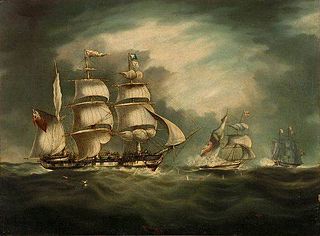
HMS Bombay Castle was a 74-gun third-rate ship of the line of the Royal Navy, launched on 14 June 1782 at Blackwall Yard. She grounded on 21 December 1796 in the shoals of the Tagus River's mouth.
HMS Defender was a 12-gun Archer-class gun-brig built in Chester in 1804 and employed in the English Channel. On 14 December 1809, she was wrecked near Folkestone.

HMS Belle Poule was a Royal Navy fifth-rate frigate, formerly Belle Poule, a Virginie-class frigate of the French Navy that had been built by the Crucy family's shipyard at Basse-Indre to a design by Jacques-Noël Sané. She was launched on 17 April 1802, and saw active service in the East. In 1806 a British squadron under Sir John Borlase Warren captured her off La Palma in the Canary Islands. The Admiralty commissioned her into the Royal Navy as HMS Belle Poule. She was sold in 1816.
Sixteen ships of the Royal Navy have borne the name HMS Viper, or HMS Vipere, after the members of the Viperidae family:

Corona was a 40-gun Pallas-class frigate of the Italian Navy. The French built her in Venice in 1807 for the Napoleonic Kingdom of Italy. The British captured Corona at the Battle of Lissa and took her into the Royal Navy as HMS Daedalus. She grounded and sank off Ceylon in 1813 while escorting a convoy.

HMS Ferret was a Royal Navy Cruizer-class brig-sloop built by Benjamin Tanner at Dartmouth and launched in 1806, 19 months late. She served on the Jamaica, Halifax, and Leith stations during which time she took three privateers as prizes before she was wrecked in 1813.
HMS Fulminante was a cutter belonging to the French Navy that the British captured in 1798, the French recaptured in 1800, and the British re-recaptured three months later. She was wrecked early in 1801.
HMS Maria was a gun-brig the Royal Navy purchased in 1807 and commissioned at Antigua in 1808. On 29 September 1808 the French Navy corvette French corvette Department des Landes captured her. The French burnt Maria in February 1809 at Martinique to prevent her recapture.

HMS Satellite was a 16-gun brig-sloop of the Seagull class built at the Hills shipyard, Sandwich, Kent, and launched in 1806. She foundered in December 1810 with the loss of all aboard.

HMS Pandora was launched in 1806. She captured two privateers before she was wrecked in February 1811 off the coast of Jutland.
The French brig Carlotta was a brig-rigged corvetta-cannoniera or, corvetta-brig, of 10 guns, launched in 1807 at Venice as Fiamma that served the French Navy as Carlotta. HMS Belle Poule captured her in 1810 and the British Royal Navy took her into service as HMS Carlotta. She was wrecked in 1812.
HMS Vautour was 16-gun brig-sloop of the British Royal Navy. The navy captured her from the French on the stocks in 1809 and commissioned her in 1810. She foundered in October 1813.
The British Royal Navy purchased HMS Nile on 3 November 1806. She was the hired armed cutter Nile. After a brief, undistinguished career, the Navy sold her in 1810 only to have to break her up in 1811.
HMS Shamrock was a schooner built at Bermuda in 1808 of Bermuda cedar. She was built for the Royal Navy and was the name-ship of her class of 10-gun schooners. She was wrecked in 1811.
HMS Wild Boar was a brig-sloop launched in 1808. She was wrecked in 1810.
HMS Serin was the French Serin, a brig-aviso, launched in 1788 at Bayonne. The Royal Navy captured her in 1794. She left Jamaica in late July 1796 and was lost without a trace, probably in August 1796.
HMS Mistletoe was launched in Bermuda in 1809 and foundered in 1816.
HMS Redbridge was the mercantile schooner Union that the Royal Navy purchased in 1804. She wrecked at Nassau, Bahamas in November 1806.
HMS Bouncer was launched at Newcastle upon Tyne in 1804 for the British Royal Navy. The French captured her in February 1805. She went through several name changes before she was condemned in 1827.
HMS Holly was launched in Bermuda in 1809. She participated in the capture of San Sebastián in 1813, a campaign that resulted in the Admiralty awarding her crew the Naval General Service Medal. She was wrecked in January 1814.







